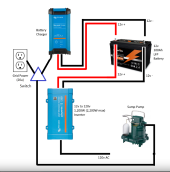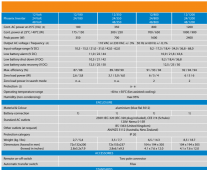You are using an out of date browser. It may not display this or other websites correctly.
You should upgrade or use an alternative browser.
You should upgrade or use an alternative browser.
Running sump pump 24/7 off LiFePo4 battery/inverter/charger
- Thread starter monochromatic
- Start date
Bud Martin
Solar Wizard
- Joined
- Aug 27, 2020
- Messages
- 4,844
monochromatic
New Member
- Joined
- Oct 28, 2022
- Messages
- 18
Thank you all for your replies! I think I'll go the Victron route and report back. 
Hi, just trying to understand the scheme and build my topology, pretty fresh of the boat))I think I would use a transfer switch instead of full time on inverter-battery.
Not sure the duty cycle or the charging power but could deplete the battery in difficult conditions even if utility power is available.
Depends on the damage risk of rising water. Or just swap the plug into the utility outlet if needed.
I also recommend a spare pump if damage risk is high. I have seen the shelves of HD cleared of all pumps and generators during times of need.
Otherwise diagram looks fine.
In case if the switch is placed before the battery charger it means that the load (pump) must be manually toggled from switch to inverter, am I right?
OK since you jumped in the bottom of this thread we don't have the perspective of your situation and equipment.Hi, just trying to understand the scheme and build my topology, pretty fresh of the boat))
In case if the switch is placed before the battery charger it means that the load (pump) must be manually toggled from switch to inverter, am I right?
Generally the charger would be powered full time by utility power.
The the transfer switch would normally send utility power to the pump. During a utility power outage the switch would connect the pump to the inverter and draw power from the battery. If you select an inverter-charger this would all be handled by one piece of equipment.
Thanks for the reply, please fix me with the scheme.OK since you jumped in the bottom of this thread we don't have the perspective of your situation and equipment.
Generally the charger would be powered full time by utility power.
The the transfer switch would normally send utility power to the pump. During a utility power outage the switch would connect the pump to the inverter and draw power from the battery. If you select an inverter-charger this would all be handled by one piece of equipment.
1) I've put the switch according to manual:

2) Have you described this topology?

Last edited:
Charger goes in the top outlet and the feed to the pump goes in the bottom outlet. Remove the triangle (switch).
The two lines near the bottom feeding the pump go to the triangle (switch) with one wire out to the pump.
The automatic transfer switch has two input and one output to the load.
Yes the second diagram works perfectly
The two lines near the bottom feeding the pump go to the triangle (switch) with one wire out to the pump.
The automatic transfer switch has two input and one output to the load.
Yes the second diagram works perfectly
Last edited:
Great, thanks for the clarification.Charger goes in the top outlet and the feed to the pump goes in the bottom outlet. Remove the triangle (switch).
The two lines near the bottom feeding the pump go to the triangle (switch) with one wire out to the pump.
The automatic transfer switch has two input and one output to the load.
Yes the second diagram works perfectly
Just wondering - even in a case with a switch the battery will still receive some voltage from the charger - will it hurt for lifepo4?
The battery will be on float continuously as the charger is plugged in direct. Best if the float voltage can be down about 13.35-13.40 for longer life.Great, thanks for the clarification.
Just wondering - even in a case with a switch the battery will still receive some voltage from the charger - will it hurt for lifepo4?
Could also disconnect the battery during periods of minimal risk of outage. If the user is not electrically inclined you could add a switch to turn on as needed. The inverter at idle will slowly drain the battery so that needs to be off too. Either way the battery will last a long time. Like most emergency equipment the best situation is that is does not get used. And likewise should be tested at least once a year.
Im looking to insteall this exact system and am glad I came across this thread. Great diagrams too! (what did you use for it?)
The Victron Phoenix has a rest mode - it shuts off when no load is attached. Turns on to check for load every 3 seconds. Just thought Id throw that in here as I read through its documentation - didnt want it on all thetime when really never being used.
Did you put a breaker anywhere on the battery side?
The Victron Phoenix has a rest mode - it shuts off when no load is attached. Turns on to check for load every 3 seconds. Just thought Id throw that in here as I read through its documentation - didnt want it on all thetime when really never being used.
Did you put a breaker anywhere on the battery side?
Hello. Lookinng to use River Pro as you detail for my similar sump pump. Does it work automatically when power goes out? . Any info you can share would be greatly appreciated. Why are you looking to switch to another setup? Thanks for your timeThank you Bentley! The sump pump is a Zoeller M53 model rated for 4.8-9.7 amps. My testing with a clamp meter is that it draws 9 amps for a split second, then operates at about 5 amps. Running time is 5 seconds to empty the pit. I can't seem to find the official specifications for the locked rotor amps (inrush). I've successfully run the sump pump off an Ecoflow River Pro (600W and 1,200W surge) for hours on end on about six different occasions, if it's any help.
Appreciate it!
Similar threads
- Replies
- 173
- Views
- 2K



